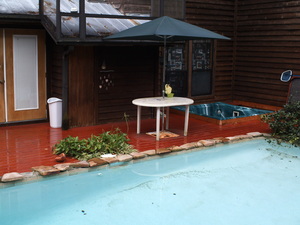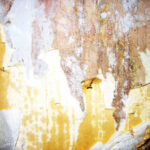Painting a wood deck not only beautifies a deck area to your own unique color specifications, it creates a lasting layer of protection from the outdoor elements, foot traffic and scuffs or scrapes. After time, paint needs to be reapplied to keep the paint looking and working like it’s supposed to. When multiple coats of paint are applied over successive years, build up of different brand name paints, aging and weather all take its toll on the paints ability to bond to the wood. When this happens, it’s time to strip the deck paint.
Stripping deck paint can easily become messy and difficult if it’s not properly done. By following this simple process, you can easily have this toxic project completed with the least amount of trouble and time.
Protection Plants don’t like deck stripper. In fact, they down right hate it so much it kills them. By spraying down plants and shrubs with plenty of water then covering them with a tarp or plastic will help reduce the risk of hurting or killing your plants and shrubs. Remove the tarps once you’re down and heavily rinse down the plants.
Seeing as how most deck strippers kill plants they can probably kill you to. It’s probably a good idea to wear protective gloves, long pants and shirt. Don’t forget the safety goggles and it might not be a bad idea to wear a respirator. Some deck strippers release some pretty toxic fumes. Always check the label and follow directions from the manufacturer.
Inside Tip: Wear old shoes or rubber boots. The chemicals in a deck paint stripper may eat away at your shoes.
Application Applying deck paint strippers can be done in several different ways and each product has its own unique application process. Always read the instructions before applying any paint stripper.
Many strippers are applied directly or with a solution of water and the product, spread or poured onto the deck and then spread around the painted surface using a brush, mop or broom. These products tend to take about and hour to really begin to work. Any product made with sodium hydroxide (lye or caustic soda) is a powerful product and works the fastest. It is a powerful base and can cause serious burns; be careful!
Another form of application is using a pressure washer. While I personally wouldn’t recommend this because a pressure washer destroys wood, there are products available on the market that pour directly into a pressure washer. They are very concentrated and should be handled with extra care.
Inside Tip: Caustic soda and Lye are powerful bases. Burns on the skin can be neutralized with white distilled vinegar (it’s an acid). Use a mix of 50/50 white distilled vinegar and water to neutralize the base before you re-paint or seal the deck.
Rinse Rinse off the deck using a hose and high pressure nozzle. Don’t use a pressure washer. If you need to get off paint that may not have been completely removed, use a wire bristle brush or stiff bristled brush to scrub away any leftover paint. You may need to reapply more stripper.
Allow the water to thoroughly rinse the deck until all of the stripper has been removed. Water down the soil and surround area extra water and allow it to soak into the ground several times. This will help dilute the toxic chemicals that may linger in puddles and washouts.
Clean up any leftover paint glob when the area is dry. Use a metal or plastic leaf rake to help scrape up stubborn pieces caught in grass or dirt around your deck. Allow the deck to dry for 48 hours before reapplying paint.





